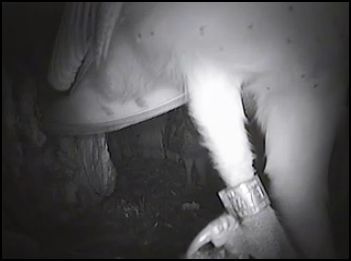BELL CANYON - A new pair of barn owls is drawing thousands of eyes back to the world-famous “owl cam” at Starr Ranch, the Audubon Society's 4,000-acre nature preserve. Ten days ago, bloggers lit up the Starr Ranch website after viewers caught sight of a tawny, spotted female barn owl going in and out of a cavity recessed inside a 50-foot-high eucalyptus tree at the sanctuary. The owl's real-time movements are captured on the owl cam, two small cameras mounted inside the cavity. For four years, the public has had access to see what the camera sees 24/7. The importance of the owl cam is twofold: It allows the public to see nature play out its course in a way not normally seen by humans, and it provides ranch scientists with an insight into the raptors' behavior.
 In one scene, the camera caught a view of how owl pairings come to be.
In one scene, the camera caught a view of how owl pairings come to be.The camera showed two owls perched on limbs attempting to get the female owl's attention. Two days later, one of the two owls had been given access to the cavity. He had a silver band around his leg inscribed with the number 174. That meant he was banded as a chick on Starr Ranch April 17, 2011, when he was about 4 weeks old, said Pete DeSimone, ranch manager. DeSimone set up the owl cam and has since been under pressure by the public to maintain the camera's operation 24/7. From the beginning of the egg watch (when the eggs are laid) to the hatching, feeding and fledging of the chicks, viewers caught a glimpse into the world of owls. But the owl cam has also drawn its share of controversy. Two years ago, when one chick struggled to survive, owl cam viewers called on DeSimone to intervene while some said nature should take its course. DeSimone chose to let nature take its course.
In a separate instance, when five chicks were left fatherless, DeSimone helped the female by making prey drops (bringing food such as rats to the nest) at night to help supplement her hunting. The cam viewers rejoiced. The five chicks fledged, were banded by DeSimone and began hunting on their own. In early May, the cavity was left empty. Despite the popularity of the cam, the number of viewers decreased once the cavity was empty. But a core group of viewers – more than a dozen scattered throughout the nation, in Europe and Asia – began reporting the appearance of the new female owl in late summer. DeSimone, busy with other research and obligations on the ranch, relies on loyal viewers, who have dubbed the eucalyptus cavity “The Ritz,” to glean information.
The two owls leave to hunt around 7 p.m. and appear again around 6 a.m. During the day, they mostly rest and preen each other. Next, viewers are hopeful to watch the mating ritual, which will lead to the egg watch. Then the cycle continues again. DeSimone, 58, has been watching wildlife and raptors for more than 30 years, 27 of them at Starr Ranch. But he didn't combine his fascination with wildlife and his technical expertise until 2008, when he climbed the eucalyptus tree and set up the owl cam.
“The coolest thing is that it has turned into a wonderful education opportunity,” DeSimone said. “They're understanding nature and through the ability to watch and record others can get to know about a wild situation. … They are watching the evolution of a pair of wild birds getting together. Without these wonderful people doing it, no one would know.
I'm blown away by the amount of people who watch and care.”


